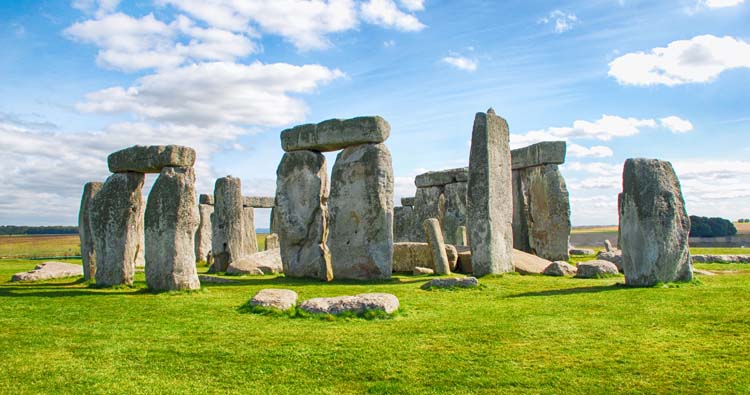Tiếng Anh 11 Unit 5 Focus Review 51. Circle the correct option to complete the sentences. 2. Match the words or phrases in the box with their definitions. 3. Fill in each blank with two words to complete the sentences. Use one word from each box. 4. The grammar mistakes in the dialogue have been underlined. Correct these mistakes using participles, to-infinitives and cleft sentences. 5. Read about Huế and answer the questions.
Lựa chọn câu để xem lời giải nhanh hơn
Bài 1 VOCABULARY AND GRAMMAR 1. Circle the correct option to complete the sentences. (Khoanh tròn phương án đúng để hoàn thành câu.) 1. I was impressed with the ______ beauty of Ha Long Bay. a. breath-taking b. archaeological c. authentic d. geological 2. Many years ago, the Champa ______ included all of Cambodia and southern Việt Nam. a. estate b. icon c. religion d. kingdom 3. Our town's ______ is ideal for tourists to take selfies at. a. masterpiece c. landmark b. culture d. kingdom 4. The city government is trying to preserve its ______. a. dynasty b. diverse ecosystem c. decorations d. landscapes 5. We had a(n) ______ time visiting Angkor Wat. a. stunning b. cultural c. archaeological d. unforgettable 6. The museum has a lot of experience in the ______ of archeological remains. a. exploration b. replacement c. preservation d. landscape Lời giải chi tiết:
1. a I was impressed with the breath-taking beauty of Ha Long Bay. (Tôi rất ấn tượng với vẻ đẹp ngoạn mục của Vịnh Hạ Long.) a. breath-taking (adj): ngoạn mục b. archaeological (adj): thuộc về khảo cổ c. authentic (adj): đích thực d. geological (adj): thuộc về địa chất 2. d Many years ago, the Champa kingdom included all of Cambodia and southern Việt Nam. (Nhiều năm trước, vương quốc Champa bao gồm toàn bộ Campuchia và miền Nam Việt Nam.) a. estate (n): tài sản b. icon (n): biểu tượng c. religion (n): tôn giáo d. kingdom (n): vương quốc 3. c Our town's landmark is ideal for tourists to take selfies at. (Thắng cảnh của thị trấn chúng tôi là nơi lý tưởng để khách du lịch chụp ảnh tự sướng.) a. masterpiece (n): kiệt tác c. landmark (n): cột mốc b. culture (n): văn hóa d. kingdom (n): vương quốc 4. b The city government is trying to preserve its diverse ecosystem. (Chính quyền thành phố đang cố gắng bảo tồn hệ sinh thái đa dạng.) a. dynasty (n): triều đại b. diverse ecosystem (n): hệ sinh thái đa dạng c. decorations (n): trang trí d. landscapes (n): cảnh quang 5. d We had an unforgettable time visiting Angkor Wat. (Chúng tôi đã có một khoảng thời gian khó quên khi đến thăm Angkor Wat.) a. stunning (adj): kinh ngạc/ choáng váng b. cultural (adj): thuộc về văn hóa c. archaeological (adj): thuộc về khảo cổ d. unforgettable (adj): khó quên 6. c The museum has a lot of experience in the preservation of archeological remains. (Bảo tàng có nhiều kinh nghiệm trong việc bảo quản các di vật khảo cổ học.) a. exploration (n): sự khám phá b. replacement (n): sự thay thế c. preservation (n): sự giữ gìn d. landscape (n): cảnh quang Bài 2 2. Match the words or phrases in the box with their definitions. (Nối các từ hoặc cụm từ trong hộp với định nghĩa của chúng.)
1. ____ very impressive 2. ______ to oppose 3. ______ an image of a person or animal made of solid materials 4. ______ extremely beautiful 5. ______ a strong fort where people could go to for safety if their city was attacked 6. ______ beliefs, way of life, and customs shared by people in a particular society 7. ______ made in a traditional or original way 8. ______ to review Lời giải chi tiết: 1. stunning = very impressive (kinh ngạc = rất ấn tượng) 2. go against = to oppose (phản đối) 3. statue = an image of a person or animal made of solid materials (bức tượng = một hình ảnh của một người hoặc động vật làm bằng vật liệu rắn) 4. magnificent = extremely beautiful (hoành tráng = cực kỳ đẹp) 5. citadel = a strong fort where people could go to for safety if their city was attacked (thành lũy = một pháo đài vững chắc nơi mọi người có thể đến để được an toàn nếu thành phố của họ bị tấn công) 6. culture = beliefs, way of life, and customs shared by people in a particular society (văn hóa = niềm tin, lối sống và phong tục được chia sẻ bởi những người trong một xã hội cụ thể) 7. authentic = made in a traditional or original way (đích thực = được thực hiện theo cách truyền thống hoặc nguyên bản) 8. go over = to review (ôn lại, xem xét lại) Bài 3 3. Fill in each blank with two words to complete the sentences. Use one word from each box. (Điền vào mỗi chỗ trống hai từ để hoàn thành câu. Sử dụng một từ từ mỗi hộp.)
1. _________ The temples and monuments attract a lot of tourists to Sukhothai. 2. After the national park became a __________site, the size of the local animal population grew. 3. We were impressed with the __________ found at the temple complex. 4. Our tour guide suggested we avoid the areas __________ visitors. 5. We are grateful for the __________ to restore the archeological remains found areas last year. Phương pháp giải: international (adj): thuộc quốc tế overcrowded (adj): đông đúc religious (adj): thuộc tôn giáo well (adv): tuyệt, tốt World (n): thế giới decorations (adj): đồ trang trí efforts (n): nỗ lực Heritage (n): Di sản preserved (Ved): được bảo tồn with (prep): với Lời giải chi tiết: 1. The well preserved temples and monuments attract a lot of tourists to Sukhothai. (Những ngôi đền và di tích được bảo tồn tốt thu hút rất nhiều khách du lịch đến Sukhothai.) 2. After the national park became a World Heritage site, the size of the local animal population grew. (Sau khi công viên quốc gia trở thành Di sản Thế giới, quy mô của quần thể động vật địa phương đã tăng lên.) 3. We were impressed with the religious decorations found at the temple complex. (Chúng tôi rất ấn tượng với những đồ trang trí tôn giáo được tìm thấy tại quần thể đền thờ.) 4. Our tour guide suggested we avoid the areas overcrowded with visitors. (Hướng dẫn viên của chúng tôi đề nghị chúng tôi tránh những khu vực đông đúc du khách.) 5. We are grateful for the international efforts to restore the archeological remains found areas last year. (Chúng tôi rất biết ơn những nỗ lực quốc tế nhằm khôi phục các di vật khảo cổ học được tìm thấy trong các khu vực vào năm ngoái.) Bài 4 4. The grammar mistakes in the dialogue have been underlined. Correct these mistakes using participles, to-infinitives and cleft sentences. (Những lỗi ngữ pháp trong cuộc đối thoại đã được gạch chân. Sửa những lỗi này bằng cách sử dụng phân từ, động từ nguyên thể có to và câu chẻ.) A: Did you see Nijo Castle when you were in Kyoto? B: Yes, we did. But ¹ was Gion that we enjoyed the most. A: Oh, what did you like about it? B: Tourists 2want to see a historic place should definitely pay a visit. It used to be a geisha district, so now female tourists visiting there often dress in kimonos. It is very traditional and full of lovely shops and teahouses. A: Sounds great. What else would you recommend seeing in Kyoto? B: I think Chion-in Temple is nice, 3but the Kiyomizu-dera Temple that you would probably like the most. A: What is so special about it? B: It's high up and gives you a stunning view of the city. It's also a World Heritage site. A: Is it a place that someone 4 learn about Japanese religion should check out? B: Yes, and it's ideal for nature lovers 5want to taking some magnificent photos. I hope you get a chance 6for visit Kyoto some day and explore it for a few days. Lời giải chi tiết: Giải thích: (1) Cấu trúc câu chẻ: It was + N + that + S + V Yes, we did. But ¹ it was Gion that we enjoyed the most. (2) Câu đã có chủ ngữ “Tourists” và động từ chính “should pay” => sau chủ ngữ là rút gọn mệnh đề quan hệ dạng chủ động “who want = wanting”. Tourists 2wanting to see a historic place should definitely pay a visit. (3) Cấu trúc câu chẻ: It was + N + that + S + V I think Chion-in Temple is nice, 3but it was the Kiyomizu-dera Temple that you would probably like the most. (4) Câu đã có chủ ngữ “some” và động từ chính “should check out” => sau chủ ngữ là rút gọn mệnh đề quan hệ dạng chủ động “who learns = learning”. Is it a place that someone 4 learning about Japanese religion should check out? (5) Cấu trúc: It’s + adj + for + O + to V; want + to V (muốn làm việc gì) Yes, and it's ideal for nature lovers 5wanting to take some magnificent photos. (6) Cấu trúc chỉ mục đích “to V” (để mà). I hope you get a chance 6to Kyoto some day and explore it for a few days. A: Did you see Nijo Castle when you were in Kyoto? B: Yes, we did. But ¹ it was Gion that we enjoyed the most. A: Oh, what did you like about it? B: Tourists 2wanting to see a historic place should definitely pay a visit. It used to be a geisha district, so now female tourists visiting there often dress in kimonos. It is very traditional and full of lovely shops and teahouses. A: Sounds great. What else would you recommend seeing in Kyoto? B: I think Chion-in Temple is nice, 3but it was the Kiyomizu-dera Temple that you would probably like the most. A: What is so special about it? B: It's high up and gives you a stunning view of the city. It's also a World Heritage site. A: Is it a place that someone 4 learning about Japanese religion should check out? B: Yes, and it's ideal for nature lovers 5to want to take some magnificent photos. I hope you get a chance 6to Kyoto some day and explore it for a few days. Tạm dịch: A: Bạn có thấy Lâu đài Nijo khi bạn ở Kyoto không? B: Vâng, chúng tớ đã thấy. Nhưng đó là Gion mà chúng tớ thích nhất. A: Ồ, bạn thích gì về nó? B: Khách du lịch muốn xem một địa điểm lịch sử chắc chắn nên ghé thăm. Nơi đây từng là quận geisha, vì vậy giờ đây các nữ du khách đến đây thường mặc trang phục kimono. Nó rất truyền thống và đầy những cửa hàng và quán trà xinh xắn. A: Nghe tuyệt thật. Bạn muốn giới thiệu điều gì khác ở Kyoto? B: Tớ nghĩ chùa Chion-in rất đẹp, nhưng có lẽ bạn sẽ thích chùa Kiyomizu-dera hơn. A: Điều gì là đặc biệt về nó? B: Nó ở trên cao và cho bạn một cái nhìn tuyệt đẹp về thành phố. Nó cũng là một di sản thế giới. A: Đó có phải là nơi mà những người tìm hiểu về tôn giáo Nhật Bản nên đến không? B: Đúng, và thật lý tưởng cho những người yêu thiên nhiên muốn chụp những bức ảnh tuyệt đẹp. Tôi hy vọng một ngày nào đó bạn có cơ hội đến Kyoto và khám phá nó trong vài ngày. Bài 5 READING 5. Read about Huế and answer the questions. (Đọc về Huế và trả lời các câu hỏi.) Located in central Việt Nam, Hue is one of Việt Nam's most beautiful cities. A trip to Huế should definitely include a visit to the Citadel (Kinh Thành). It is one of Hue's top attractions. The Citadel was built 200 years ago and is quite large. The entire site will take about a day to see. It was originally designed to protect the Vietnamese royal family and has a deep moat and 10 gateways of thick stone. Nearby the citadel are the Royal Tombs which tourists may enjoy as well. Another historical place worth visiting is the Forbidden Purple City. This was a private space for the royal family and their servants. Make sure to see the Emperor's Reading Room. It has beautiful walls and roofs which are still well-preserved. You should also visit the Royal Theatre. Every day it offers cultural dances and plays for tourists. The trip to Hue is not complete without a visit to the Thiên My Pagoda. One of Việt Nam's most famous pagodas, it is located next to the Perfume River. It has a 21-metre-tall tower constructed in 1844. It is a favorite place for visitors, so it does get a bit overcrowded with people. If you want to escape the heat, try visiting the Royal Fine Arts Museum. Here, you can learn about Hue's history and enjoy many stunning works of art. If you are in Hue during April, you might visit the Hue Festival where you can see the city's culture, music, and art. 1. When was the Citadel built? (Kinh thành được xây dựng khi nào?) ___________________________________ 2. How many gateways does the Citadel have? (Hoàng Thành có bao nhiêu cổng?) ___________________________________ 3. Where did the royal family live? (Gia đình hoàng gia đã sống ở đâu?) ___________________________________ 4. How tall is the Thiên Mụ Pagoda? (Chùa Thiên Mụ cao bao nhiêu?) ___________________________________ 5. Where can you find impressive works of fine art? (Bạn có thể tìm thấy những tác phẩm mỹ thuật ấn tượng ở đâu?) ___________________________________ 6. In which month is the Hue Festival held? (Festival Huế diễn ra vào tháng mấy?) ___________________________________ Phương pháp giải: Tạm dịch: Nằm ở miền trung Việt Nam, Huế là một trong những thành phố đẹp nhất của Việt Nam. Một chuyến đi đến Huế chắc chắn nên bao gồm một chuyến thăm Đại Nội (Kinh Thành). Đó là một trong những điểm thu hút hàng đầu của Huế. Đại Nội được xây dựng cách đây 200 năm và khá lớn. Toàn bộ địa điểm sẽ mất khoảng một ngày để xem. Ban đầu nó được thiết kế để bảo vệ hoàng gia Việt Nam và có một con hào sâu và 10 cổng bằng đá dày. Gần thành cổ là Lăng mộ Hoàng gia mà khách du lịch cũng có thể thưởng thức. Một địa điểm lịch sử khác đáng ghé thăm là Tử Cấm Thành. Đây là không gian riêng tư dành cho hoàng gia và những người hầu cận của họ. Hãy chắc chắn đến xem Phòng đọc sách của Hoàng đế. Nó có những bức tường và mái nhà đẹp vẫn được bảo tồn tốt. Bạn cũng nên ghé thăm Nhà hát Hoàng gia. Mỗi ngày nó cung cấp các điệu nhảy và vở kịch văn hóa cho khách du lịch. Chuyến đi đến Huế sẽ không trọn vẹn nếu không ghé thăm chùa Thiên Mỹ. Một trong những ngôi chùa nổi tiếng nhất của Việt Nam, nó nằm cạnh sông Hương. Nó có một tòa tháp cao 21 mét được xây dựng vào năm 1844. Đây là một địa điểm yêu thích của du khách nên hơi đông đúc. Nếu bạn muốn thoát khỏi cái nóng, hãy thử ghé thăm Bảo tàng Mỹ thuật Hoàng gia. Tại đây, bạn có thể tìm hiểu về lịch sử của Huế và thưởng thức nhiều tác phẩm nghệ thuật tuyệt đẹp. Nếu bạn ở Huế vào tháng 4, bạn có thể ghé thăm Festival Huế, nơi bạn có thể xem văn hóa, âm nhạc và nghệ thuật của thành phố. Lời giải chi tiết: 1. The Citadel was built 200 years ago. (Thành cổ được xây dựng cách đây 200 năm.) 2. The Citadel has 10 gateways. (Kinh thành có 10 cửa.) 3. The royal family lived in the Forbidden Purple City. (Gia đình hoàng gia sống ở Tử Cấm Thành.) 4. The Thiên Mụ Pagoda is 21 metres tall. (Chùa Thiên Mụ cao 21 mét.) 5. We can find impressive works of fine art at Royal Fine Arts Museum. (Chúng ta có thể tìm thấy những tác phẩm mỹ thuật ấn tượng tại Bảo tàng Mỹ thuật Hoàng gia.) 6. In April. (Vào tháng 4.) Bài 6 WRITING 6. Choose one from the list of World Heritage sites on page 52 and write a passage (150-180 words) about it. Search the Internet and add pictures. (Chọn một trong danh sách Di sản Thế giới ở trang 52 và viết một đoạn văn (150-180 từ) về nó. Tìm kiếm trên Internet và thêm hình ảnh.) Lời giải chi tiết: Stonehenge is the name of an ancient stone monument. It is located in southern England and dates back to the Stone Age. The complex has looked different throughout history. It is unknown how the facility was constructed. The stones had to be brought over a long distance. Some stones have been smoothed very carefully, which must have been long, hard work. Stonehenge is not entirely unique, but the complex is still impressive because of the six- metre and seventy - centimeters stone. A million tourists per year want to visit Stonehenge. Some of them smeared paint on rocks or broke off pieces as a memento. So since 1978, fences have been used to prevent them from getting too close to the stones. You can also find out more about Stonehenge in the nearby museum. This complex has been a UNESCO World Heritage Site since 1986. If you have a chance to travel to England, do not forget to visit this masterpiece.
Tạm dịch: Stonehenge là tên của một di tích bằng đá cổ đại. Nó nằm ở miền nam nước Anh và có từ thời kỳ đồ đá. Khu phức hợp đã trông khác nhau trong suốt lịch sử. Không biết khu phức hợp này được xây dựng như thế nào. Những viên đá phải được mang qua một quãng đường dài. Một số viên đá đã được mài nhẵn rất cẩn thận, chắc hẳn đã phải làm việc rất lâu và vất vả. Stonehenge không hoàn toàn độc đáo, nhưng khu phức hợp này vẫn gây ấn tượng bởi những phiến đá cao sáu mét bảy mươi centimet. Một triệu khách du lịch mỗi năm muốn đến thăm Stonehenge. Một số người trong số họ đã bôi sơn lên đá hoặc phá vỡ các mảnh để làm kỷ niệm. Vì vậy, kể từ năm 1978, hàng rào đã được sử dụng để ngăn chúng đến quá gần những viên đá. Bạn cũng có thể tìm hiểu thêm về Stonehenge trong bảo tàng gần đó. Quần thể này đã được UNESCO công nhận là Di sản Thế giới từ năm 1986. Nếu có dịp du lịch Anh, bạn đừng quên ghé thăm kiệt tác này.
>> 2K9 Học trực tuyến - Định hướng luyện thi TN THPT, ĐGNL, ĐGTD ngay từ lớp 11 (Xem ngay) cùng thầy cô giáo giỏi trên Tuyensinh247.com. Bứt phá điểm 9,10 chỉ sau 3 tháng, tiếp cận sớm các kì thi.
|






















